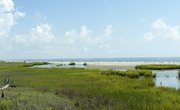
Buffalo grass is a resilient turf grass, which has survived insect invasions, droughts and floods for millions of years. This hardy grass type is found in the United States, and is the only turf grass native to this country. Buffalo grass can draw both nutrients and water from an extended area, because it possesses a root system that travels several feet into the earth. This fine-leafed turf grass can also grow and thrive on very little water, and is typically resistant to turf insects, such as webworms, billbugs and grubs.
Soil Chemistry
Each region has its own specific soil chemistry in regard to acidity or alkalinity. Buffalo grass prefers a well-drained soil with a pH between 6.0 and 8.0, but can adapt to some extent to sand soil. Buffalo grass adapts to a pH higher than 8.0, although it does not exhibit its typical dark green color.
Symbiotic Coexistence with Other Plants
Buffalo grass establishes itself as a short grass that spreads by means of stolons or runners. Although the 3- to 6-inch high runners form a solid turf, they can accommodate other native grass species and wildflowers. In this way, buffalo grass can establish itself in areas where other vegetation already grows.
Insect Damage and Disease
Buffalo grass can fight fungi and is highly resistant to common turf insects. This ability to resist insects allows buffalo grass to establish itself in new environments with insect species it has not encountered before. Although this warm-season perennial may be affected by mites in areas where it establishes itself for the first time, the condition known as “witch's broom” only causes dwarfing of the grass during its first year, but is not able to kill it.
Climate and Water Requirements
As a native grass species, buffalo grass is highly resistant to drought conditions. This grass grows profusely on ¼-inch water per week. Buffalo grass is, therefore, highly adaptable to new environments with limited rainfall. This soft-textured grass type also tolerates extremes of both heat and cold, which allows buffalo grass to adapt to almost any climatic conditions. Buffalo grass become partially dormant when exposed to drought, which allows this grass type to survive even very lengthy dry periods. This grass requires as little as six hours per day of sunlight to thrive. Buffalo grass can also tolerate short periods of flooding.
References
About the Author
Virtually growing up in a computer repair shop, Naomi Bolton has held a passion for as long as she can remember. After earning a diploma through a four year course in graphic design from Cibap College, Bolton launched her own photography business. Her work has been featured on Blinklist, Gameramble and many others.
